Blogs

Understanding Phosphor Bronze Properties: A Complete Tutorial for Engineers
Introduction
Phosphor bronze stands out as a remarkable alloy, celebrated for its unique composition and robust characteristics that cater to a diverse range of industries. Comprising primarily copper, tin, and phosphorus, this alloy not only exhibits exceptional strength and fatigue resistance but also boasts remarkable corrosion resistance, making it indispensable in demanding environments such as aerospace and marine applications.
Its ability to perform under extreme conditions, coupled with its electrical conductivity, positions phosphor bronze as a preferred material for critical components, from non-sparking tools to precision instruments.
As industries evolve and the demand for high-performance materials increases, understanding the distinct advantages and applications of phosphor bronze becomes essential for procurement managers aiming to enhance operational efficiency and ensure reliability in their supply chains.
This article delves into the fundamentals, properties, and strategic applications of phosphor bronze, providing valuable insights for those navigating the complexities of material selection in today’s competitive landscape.
Fundamentals of Phosphor Bronze: Composition and Characteristics
The distinguished alloy known for its phosphor bronze properties is predominantly comprised of copper, tin, and phosphorus, typically featuring a composition of approximately 90% copper and 10% tin, complemented by trace amounts of phosphorus. This unique blend significantly enhances the alloy’s strength and fatigue resistance, highlighting the phosphor bronze properties that make it exceptionally dependable in challenging uses. The excellent corrosion resistance and ability to endure extreme conditions of phosphor bronze properties make it widely utilized in the marine and aerospace industries, with applications including:
- Propellers in marine settings
- Aircraft bearings in aerospace
In explosive environments, the use of Non-Sparking Tools made from copper alloys is critical, as they prevent potential ignition sources while maintaining mechanical integrity. Celebrated for its exceptional electrical conductivity, the phosphor bronze properties of this alloy are crucial for various electrical and electronic components. Moreover, the phosphor bronze properties that enable it to retain mechanical characteristics even at elevated temperatures position it as a preferred material in numerous engineering fields.
The tactical application of copper-tin alloy not only highlights its performance advantages but also aligns with current industry standards, ensuring optimal functionality in applications that leverage phosphor bronze properties, from precision strips to marine components. Moreover, copper-tin alloy is favored over brass for cymbals because of its enhanced resilience, further demonstrating its superior performance traits. Suppliers and manufacturers of electrical insulation materials, such as those providing high-temperature fabrics and electrical insulation papers, play a vital role in the procurement process, ensuring quality and reliability in global trade.
As Goldsupplier states, ‘trusted and recognized internationally,’ the strategic procurement of phosphor metal and related materials ensures quality and reliability in global trade.
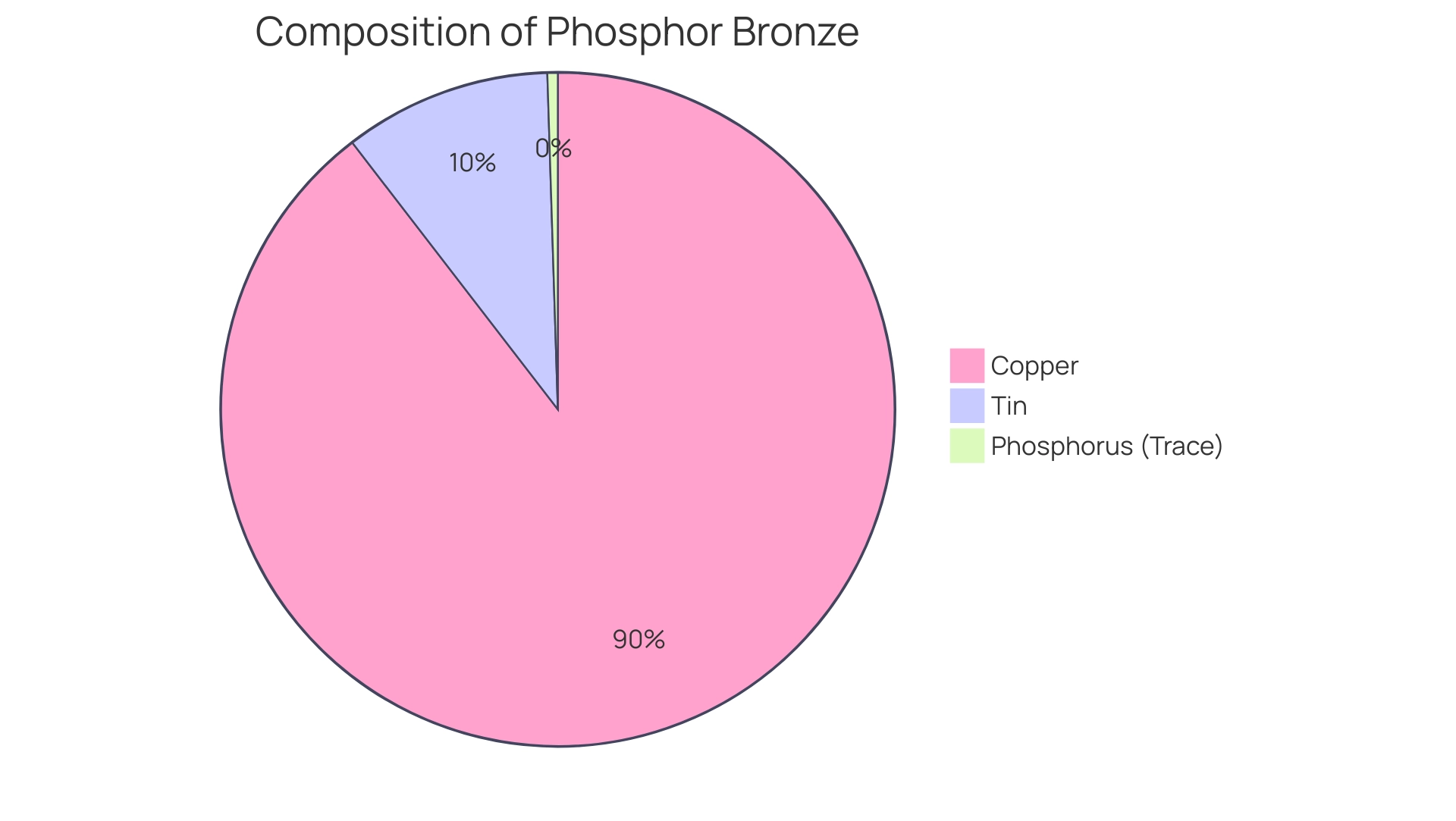
Key Properties of Phosphor Bronze: Mechanical and Thermal Insights
Phosphor bronze properties are notable for their exceptional mechanical characteristics, with a tensile strength that ranges from 450 to 800 MPa, depending on the specific alloy grade. This formidable strength is complemented by a hardness value that can reach up to 230 HB, making it ideal for uses demanding significant durability, including in explosive environments where Non-Sparking Tools are required. The specific phosphor bronze properties of the alloy, such as its ability to withstand heavy loads and retain mechanical integrity even at elevated temperatures, affirm its reliability in hazardous settings.
Furthermore, the density of this alloy is approximately 8.8 g/cm³, which is a significant factor in its overall performance. The alloy demonstrates remarkable thermal conductivity, usually about 30 W/m·K, especially advantageous in applications where efficient heat dissipation is essential. However, it is important to note that phosphor alloy has some disadvantages, including lower conductivity and a higher cost compared to other materials.
As noted by materials scientists, ‘Phosphor alloy’s main disadvantages can be its lower conductivity, as phosphorus will reduce the ability of the metal to conduct current, and its price tag.’ The phosphor bronze properties contribute to its status as a favored option for uses such as springs, connectors, bushings, and bearings—essential components in industrial environments that often utilize Non-Sparking Tools. The capability of this alloy to endure substantial loads and extended service life, attributed to its phosphor bronze properties, increases its worth in such uses, rendering it essential for procurement managers to evaluate its characteristics alongside other high-temperature substances offered by reliable suppliers.
Furthermore, associated items like electrical insulation papers, high-temperature fabrics, and specialized coatings further enhance the application of copper alloy in ensuring safety and performance in explosive environments.
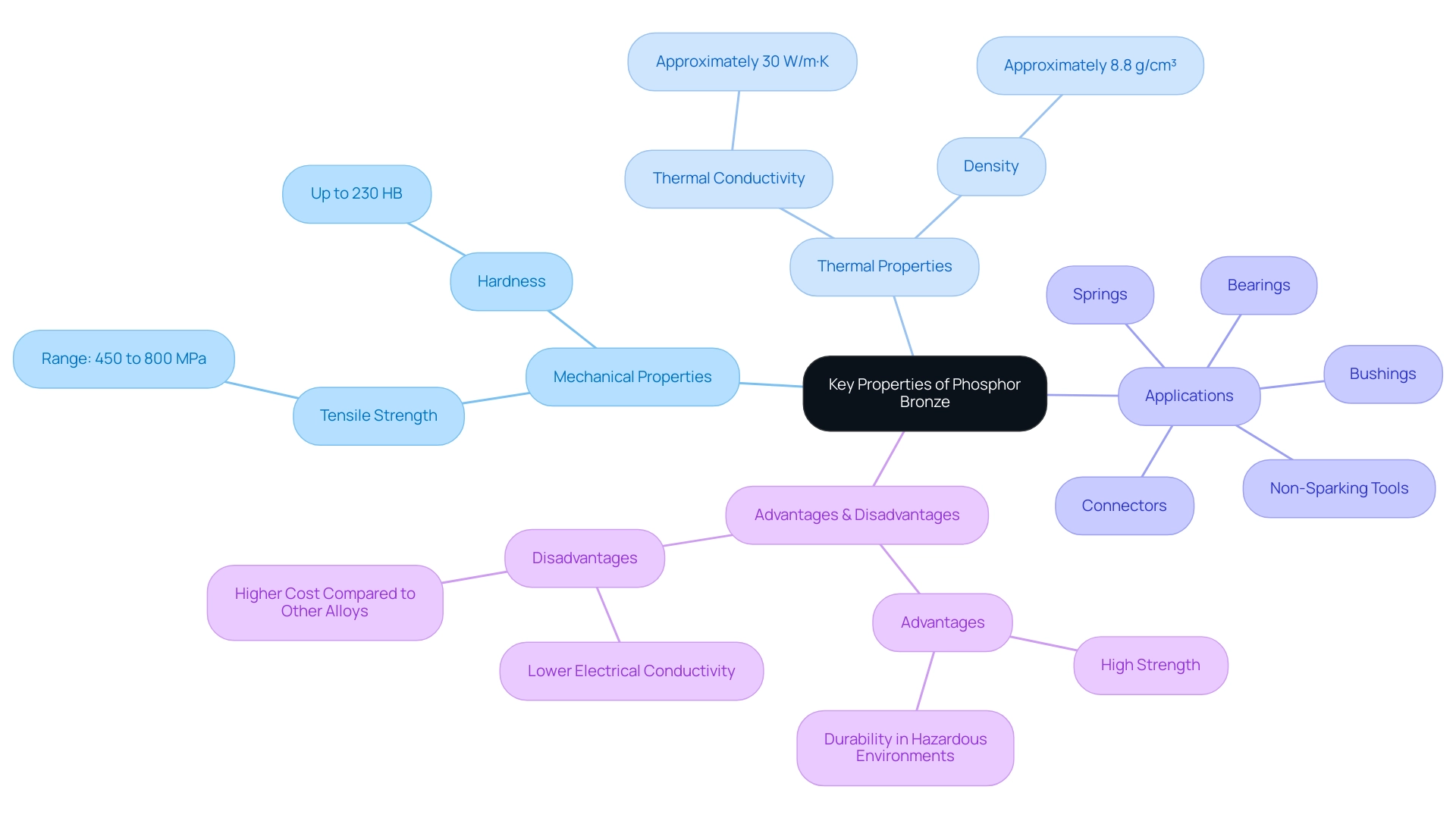
Comparative Advantages of Phosphor Bronze Over Brass
The distinct advantages of phosphor bronze properties over brass are particularly evident in terms of corrosion resistance and fatigue strength. The typical composition of CuSn8P, which includes 7.5 – 8.5% tin, 0.2 – 0.4% phosphorus, and the balance being copper, is essential for its remarkable phosphor bronze properties. While brass is known for its malleability and ease of fabrication, the superior durability and wear resistance of this metal make it perfect for essential uses such as springs, connectors, and fasteners.
Furthermore, this alloy excels in preserving its mechanical characteristics in severe environmental conditions, frequently leading to a considerably extended lifespan in challenging applications relative to brass. Phosphor alloy sleeve bearings, for example, demonstrate phosphor bronze properties that make them widely utilized in industries such as automotive, marine, and aerospace due to their excellent wear resistance, low friction, and high fatigue strength. This highlights the dependability of this alloy in engineering, backed by its established history of performance.
As Mr. Edwyne Fernandes states, ‘Our analysts are adept at integrating modern data collection methods with superior research methodologies, ensuring the production of precise and insightful research based on years of collective experience and specialized knowledge.’ This expertise strengthens the benefits derived from phosphor bronze properties in diverse uses.
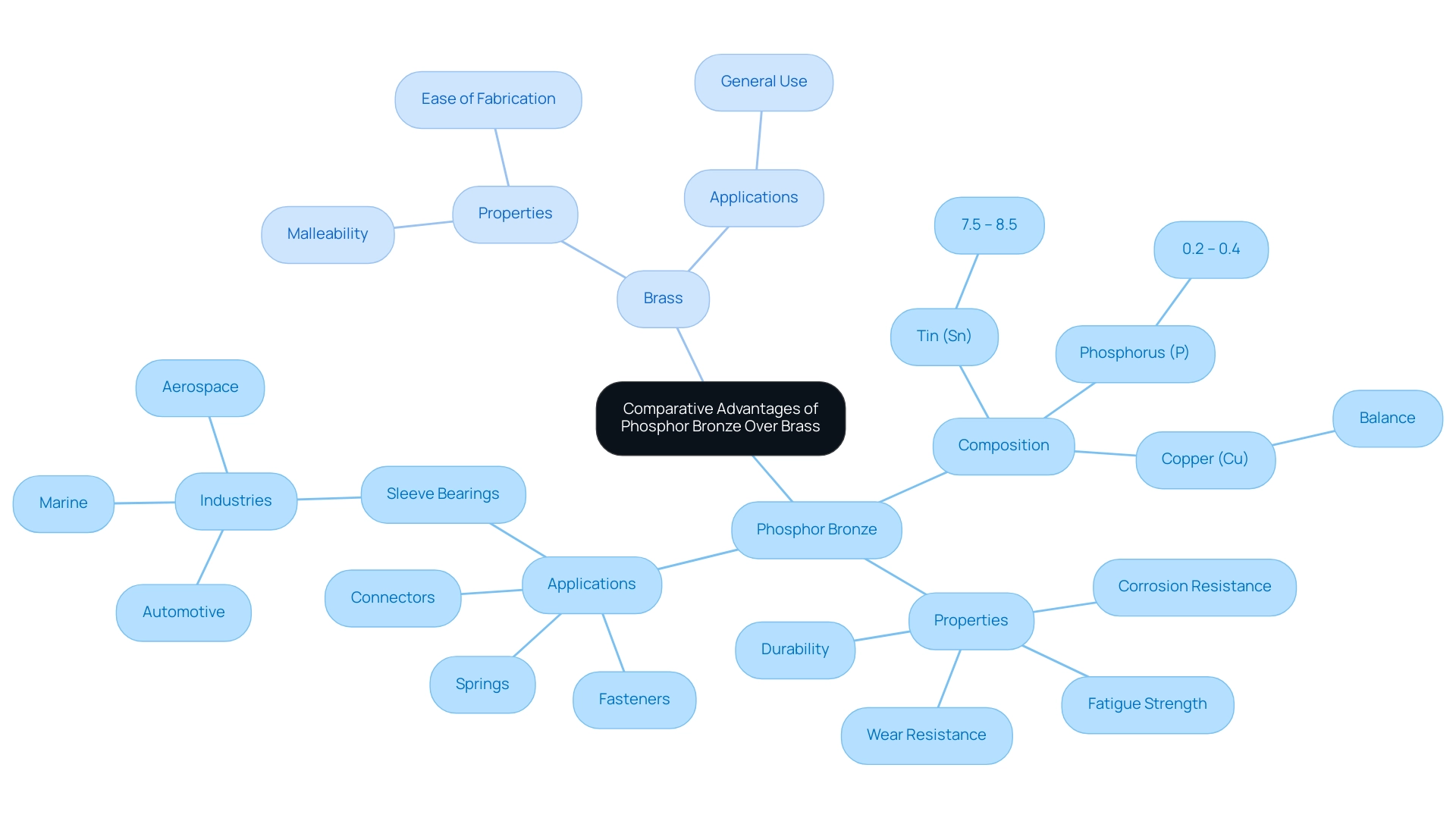
Applications of Phosphor Bronze in Engineering and Industry
Phosphor alloy is a vital substance in various sectors, particularly in automotive, electronics, and marine uses. The excellent electrical conductivity and exceptional wear resistance are part of the unique phosphor bronze properties that make it ideal for use in electrical connectors, switches, and precision instruments. In the automotive industry, copper-tin alloy components such as valve springs and bearings are crucial due to their strength and fatigue resistance, which are vital for high-performance applications.
A key recommendation for overmolding high precision components is to utilize a rectangular shape to prevent spinning under torque pressure, showcasing the material’s adaptability in manufacturing. The corrosion resistance of the material, showcasing its phosphor bronze properties, further underscores its value in marine environments, where durability against harsh conditions is paramount. Recent partnerships, like that of Micro Precision Components with automotive clients, illustrate the creative application of a specific alloy to develop precision parts that not only improve performance by minimizing noise and vibration but also aid in creating lighter, more economical designs.
For instance, in the case study titled ‘Double Take – Geometric Machined Parts,’ Micro Precision recommended a rectangular shape to eliminate spinning in the plastic overmold, resulting in smoother edges and improved production efficiency. Furthermore, the lead time for component production has remarkably reduced from six months to only ten weeks, directly emphasizing the efficiency improvements linked to the use of a certain alloy in manufacturing processes. This blend of characteristics, particularly the phosphor bronze properties, guarantees that specialized alloys continue to be a favored option in both the automotive and electronics sectors, preserving a substantial market presence while facilitating the newest uses.
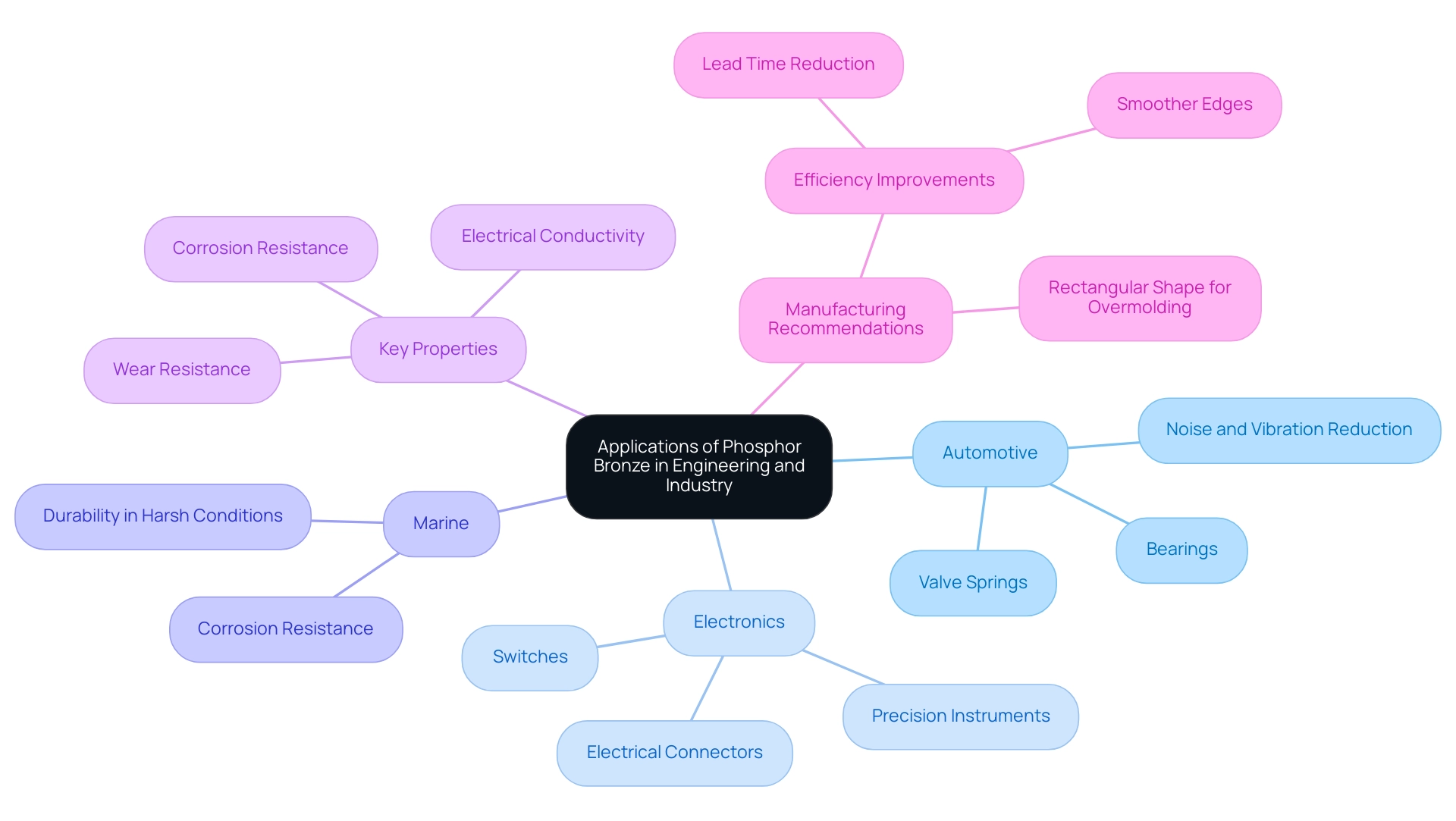
The Role of Tin and Phosphorus in Enhancing Phosphor Bronze Properties
Tin is crucial for enhancing both the corrosion resistance and durability of copper-tin alloys. Its presence creates a protective surface layer that effectively mitigates oxidation and wear, thus enhancing durability. Phosphorus, conversely, plays a crucial role in augmenting the alloy’s strength and hardness, rendering it less susceptible to deformation under stress.
Together, these elements work in harmony to enhance the overall performance of the alloy, ensuring it maintains its integrity and functionality even in challenging uses. Current research indicates that the optimal phosphorus content can significantly enhance the mechanical properties of the alloy, thereby improving the phosphor bronze properties and leading to superior performance outcomes. With the Phosphor Bronze Industry projected to grow at a Compound Annual Growth Rate of 4.49% from 2023 to 2030, the relevance of this material is increasingly recognized.
For instance, Taylor Guitars’ transition to D’Addario Coated XS Phosphor Bronze Strings highlights the material’s role in improving sound quality, with the company stating that ‘They make a guitar sound musical.’ This real-world example underscores the critical impact of phosphorus on alloy strength and hardness, solidifying its importance in both industrial and artistic domains. Additionally, the phosphor bronze properties of bearings with graphite lubricant provide a maintenance-free solution, further illustrating the versatility and practical applications of this alloy.
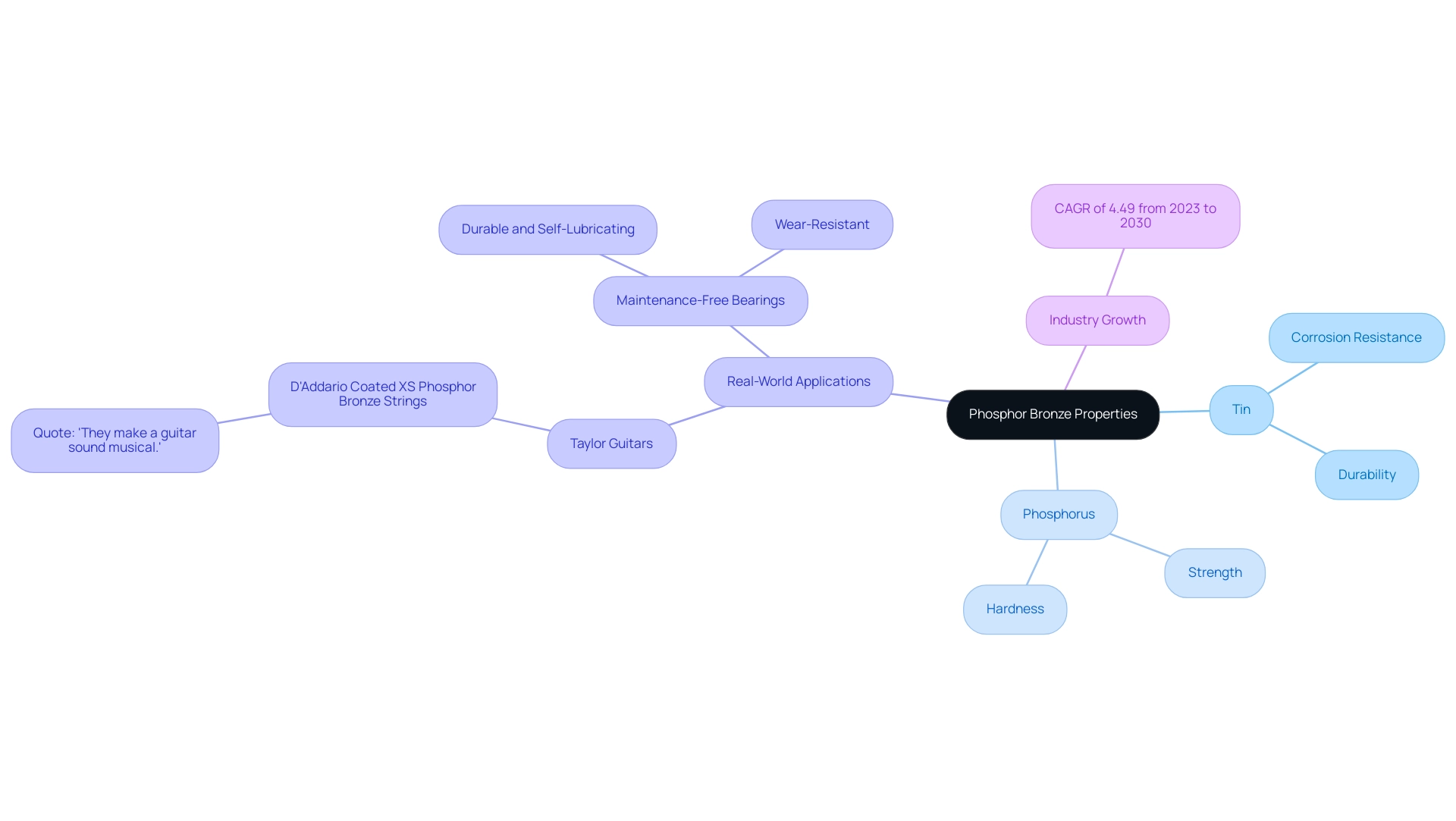
Conclusion
Phosphor bronze emerges as a vital alloy with unmatched properties that cater to a wide array of industrial applications. Its unique composition, primarily consisting of copper, tin, and phosphorus, equips it with exceptional strength, fatigue resistance, and corrosion resilience. The strategic use of phosphor bronze in sectors such as aerospace, automotive, and marine showcases its capability to perform under extreme conditions, making it an indispensable choice for critical components.
The advantages of phosphor bronze over alternatives like brass are clear, particularly regarding durability and wear resistance. Its ability to maintain mechanical integrity in harsh environments ensures that it not only meets but exceeds the demands of modern engineering challenges. As industries continue to evolve, the growing recognition of phosphor bronze’s benefits becomes increasingly crucial for procurement managers seeking reliable materials that enhance operational efficiency.
In summary, understanding the properties and applications of phosphor bronze is essential for making informed material selections. Its performance characteristics not only align with industry standards but also pave the way for innovation across various sectors. Embracing phosphor bronze as a core material will undoubtedly contribute to the reliability and success of engineering projects, reinforcing its position as a preferred choice in today’s competitive landscape.




